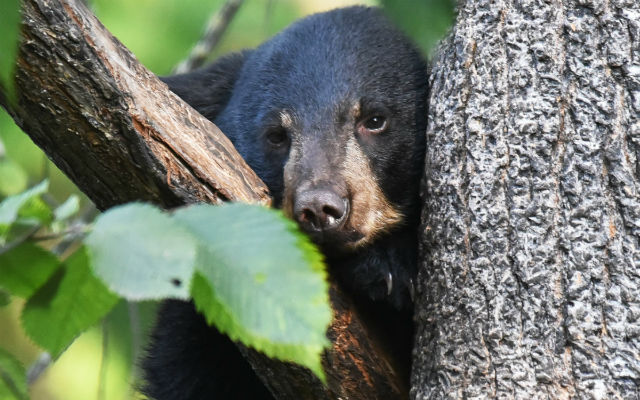
Source: CC by SA 2.0/Flickr
Plans set in motion to help repopulate and protect endangered black bears in Shikoku
Related Article
-

Kirby Dream Land masks released in Japan
-

Foxy Kitsune-Mask Band Rocks Out To Utada Hikaru, Lupin, Arrietty, and More On Traditional Japanese Instruments
-

High Quality Tea And Coffee Blended To Perfection In Kyoto’s “Japanese-Style Coffee”
-

Hiroshima Art Museum Has To Turn Away Curious Cats During Feline Art Exhibits
-

NAKED co-creates ‘new normal’ pandemic adapted night-worship with Toyokawa Inari, with protective fox masks and distance lanterns
-

These Burgers So Cheesy And Stretchy They Come With Measuring Bibs


Most people know japan for its iconic landmarks such as Mount Fuji or the giant torii gate on Miyajima island, fewer people however, are aware of the country’s natural beauty and the creatures that call it home.
One of the country’s resident animals that can be found in mountainous areas on the Japanese Archipelago, is the Asiatic Black bear. This small subspecies of black bear could once be found heavily concentrated across three of Japan’s main islands, with populations documented in Kyushu, Shikoku and across the thick forested mountain regions of Honshu.
However, heavy poaching and clashes with farmers and rural villages over the last 200 years have led to a rapid decline in bear numbers and has also completed decimated the population that was once distributed across Kyushu’s Kumamoto region – the name Kumamoto remaining one of the only indications of the former existence of bears in the area. The literal translation of the name means “origin of the bear”.
Source:Tambako The Jaguar | CC by ND 2.0
One of the main factors behind bear poaching in Japan is the animal’s tendency to destroy crops; often raiding staple food crops such as bamboo shoots, rice and sweet potatoes during the spring and autumn, as well as feeding on watermelon, plums and corn in the summer.
The bear has also been found to be a nuisance for the country’s logging industry, as they can be found stripping the bark from trees marked for felling. An estimated 12km’s land had been affected by bears stripping bark in late 1970’s alone.
The bear is not just a nuisance for farmers and logging industries across japan, but also poses a serious danger to people who might happen to cross paths with the animal. 2016 saw a year with several fatalities caused by the bear, with 4 deaths recorded in Akita prefecture during bamboo shoot foraging, and a fifth death when a member of staff at a safari park in Gunma prefecture was attacked and mauled by a bear in her car. Since then, a number of sightings and captures of Asiatic black bears have occurred in residential areas, for example, in 2018 a bear was discovered inside a home in Kudamatsu city, Yamaguchi prefecture. The animal was captured and ultimately put down by local authorities, but just two days later a second juvenile bear was caught wandering a residential area of Tokuyama city, a city which shares a border with Kudamatsu (the cub was released in the mountains). Both cities are not known for regular sightings of bears.
The capture and killing of bears has become less common over the past few decades, but of course the local municipalities do have the right to cull and control certain animals in order to stop economic disasters and to reduce the risk to local residents.
In Shikoku, the population of black bears has been dwindling so much over the last 3 decades that the Japan Bear Network has had to step in and has now proposed a protection area to the local authorities.
In a news release, the organisation highlighted their findings and proposal for the area.
Source:Courtney Celley/USFWS | CC0
The organisation reports that although no hunting or extermination of bears has taken place in Shikoku since 1986, only a small number of animals have been located in the most central and remote part of the island. From their findings over the last few years, the Japan Bear Network estimates that the total population of bears in the Shikoku region is between 16 to 24 individuals. In 2018 the organisation could only reliably identify 17 bears, 4 of which were cubs.
It is believed that one reason why the numbers remain critical in the Shikoku area is the lack of genetic diversity amongst the bears, the root cause of which would have been due to over-hunting and extermination efforts from humans.
With the bears in Shikoku on the brink of extinction, the Japan Bear Network believes it is necessary to take immediate action in order to protect the remaining animals in the area.
Working in collaboration with Shikoku Natural History Research Center and the Japan Natural Conservation Association, the Japan Bear Network has outlined the following four points in order to repopulate and protect the bear population in Shikoku:
1. Implementation of a “rare beast protection plan”
The teams have requested that the Ministry of Environment formulate a “rare beast protection plan” for the area.
The plan should include actively increasing the number of bears in the area, regular monitoring of the bear population, conservation of bear habitats, raising awareness of the plan and about the bears amongst local communities and finding collaborative ways to involve residents and businesses in the plan.
2. Expansion of Asiatic Black Bear Habitats
In order to increase the population of bears, the area they live in must also increase. This proposal recommends expanding already existing suitable bear habitats and creating wildlife corridors for the animals to safely travel through.
3. Correct handling and release of bears caught by Mistake
In 2013 a culling system was put in place in order to control the number of sika deer and wild boar in the area, which have been affecting the local forests and agriculture. An increase in traps set up in the area has also led to a rise in the number of bears caught by mistake.
The proposal calls for a tracking system to be set up and that bears be fitted with monitoring devices, so that if any are caught in traps by accident, responders can act immediately and release the animals before they cause harm or danger to themselves or trappers. If the animal has been injured, responders will be able to take it to a vet without any delay.
4. Promotion of Sustainable Development Goals
Setting up a plan to protect the population of bears in the Shikoku region will not be enough to help keep the bears out of the critical level of endangerment in the future. In order to increase the chances of survival of bears in the area, the organisations propose that the Ministry of Environment includes the Black Bear protected area of Shikoku as part of Shikoku’s sustainable development goals (SDG’s). By actively promoting SDG’s, sustainability of both the region and it’s bear population will be ensured for years to come.
Source:tontantravel | CC by SA 2.0
The Japan Bear Network and the other collaborating organisations are also urging the promotion of the proposal by the public. The hope is that by raising awareness and by taking action to promote this proposal and plan, the population of Asiatic black bears within Shikoku (and eventually the rest of Japan) will begin to increase and will ultimately lead to the protection of the animals.
The Japan Bear Network, Shikoku Natural History Research Center and the Japan Natural Conservation Association will continue to collaborate and to support campaigns put in place for protection of bears and other critically endangered animals found in both the Shikoku region and across the rest of Japan.